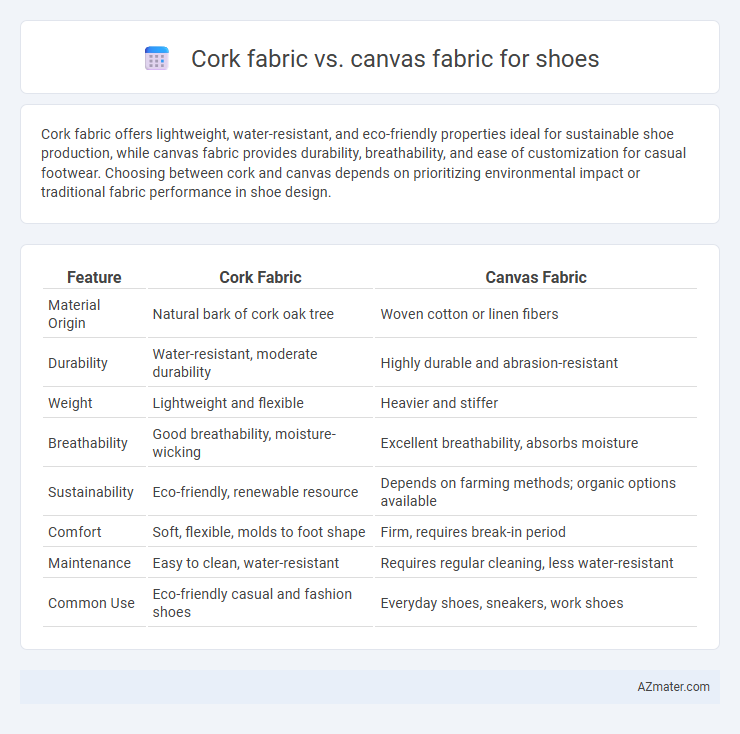Cork fabric offers lightweight, water-resistant, and eco-friendly properties ideal for sustainable shoe production, while canvas fabric provides durability, breathability, and ease of customization for casual footwear. Choosing between cork and canvas depends on prioritizing environmental impact or traditional fabric performance in shoe design.
Table of Comparison
| Feature | Cork Fabric | Canvas Fabric |
|---|---|---|
| Material Origin | Natural bark of cork oak tree | Woven cotton or linen fibers |
| Durability | Water-resistant, moderate durability | Highly durable and abrasion-resistant |
| Weight | Lightweight and flexible | Heavier and stiffer |
| Breathability | Good breathability, moisture-wicking | Excellent breathability, absorbs moisture |
| Sustainability | Eco-friendly, renewable resource | Depends on farming methods; organic options available |
| Comfort | Soft, flexible, molds to foot shape | Firm, requires break-in period |
| Maintenance | Easy to clean, water-resistant | Requires regular cleaning, less water-resistant |
| Common Use | Eco-friendly casual and fashion shoes | Everyday shoes, sneakers, work shoes |
Introduction to Cork and Canvas Fabrics
Cork fabric, derived from the bark of the cork oak tree, is a sustainable, lightweight, and water-resistant material favored for eco-friendly shoe production. Canvas fabric, typically made from cotton or linen, is known for its durability, breathability, and versatility, making it a popular choice for casual and athletic footwear. Both fabrics offer distinct advantages, with cork emphasizing environmental benefits and canvas excelling in robustness and comfort.
Origins and Manufacturing Processes
Cork fabric originates from the bark of the cork oak tree predominantly found in Portugal and Spain, harvested sustainably without harming the tree, while canvas fabric is traditionally made from cotton or linen fibers woven into a sturdy textile, with origins tracing back to ancient Egypt and Mesopotamia. Cork undergoes a process of granulating, heating, and bonding cork particles with polyurethane or latex to create a flexible, lightweight fabric, whereas canvas is produced through tightly woven yarns, often treated with wax or plastic coatings for added durability and water resistance. The eco-friendly and renewable nature of cork fabric contrasts with the agricultural demands and heavier environmental footprint associated with cotton canvas production.
Environmental Impact and Sustainability
Cork fabric, harvested from the renewable bark of cork oak trees, offers exceptional sustainability due to its biodegradability and carbon sequestration properties, making it an eco-friendly alternative to traditional materials. Canvas fabric, typically made from cotton or synthetic fibers, often involves intensive water use and pesticide application in cotton farming, resulting in a larger environmental footprint. Choosing cork fabric for shoes reduces waste and reliance on fossil fuels, while canvas production's sustainability varies significantly based on agricultural and manufacturing practices.
Durability and Longevity
Cork fabric offers excellent durability due to its natural resistance to water, mold, and abrasion, making it a sustainable choice for shoe uppers with long-lasting performance. Canvas fabric provides strong wear resistance and breathability but tends to degrade more quickly under heavy use and exposure to moisture. For shoes requiring extended longevity and environmental benefits, cork fabric outperforms canvas in maintaining structural integrity over time.
Comfort and Breathability
Cork fabric offers superior comfort and breathability for shoes due to its natural, lightweight, and porous structure that allows air circulation and moisture regulation. Canvas fabric, while durable and breathable, tends to be less cushioned and may retain heat more, leading to reduced comfort over extended wear. Choosing cork fabric enhances foot ventilation and cushioning, making it ideal for shoes that prioritize comfort and breathability.
Aesthetic Appeal and Style Options
Cork fabric offers a unique, natural texture with a warm, earthy aesthetic that enhances eco-friendly and contemporary shoe designs, while canvas fabric provides a versatile and classic appearance available in numerous colors and patterns, suitable for casual and urban styles. Cork's distinct grain and matte finish create a sophisticated, minimalist look that appeals to sustainable fashion enthusiasts, contrasting with canvas's durability and adaptability for bold prints and customizations. Both materials allow for diverse style options, but cork's organic charm makes it preferable for elegant, eco-conscious footwear, whereas canvas excels in casual, sporty, or artistic shoe designs.
Maintenance and Cleaning Requirements
Cork fabric for shoes offers natural water resistance and easy maintenance by simply wiping with a damp cloth, making it less prone to stains and odor buildup compared to canvas. Canvas fabric requires more frequent cleaning, often needing gentle washing or spot treatment with mild detergents to prevent dirt accumulation and mildew. Both materials benefit from air drying, but cork's antimicrobial properties reduce the frequency of deep cleaning needed against everyday wear.
Cost and Availability
Cork fabric for shoes typically costs more due to its sustainable harvesting process and limited production, making it less widely available than canvas. Canvas fabric is generally affordable and widely accessible, produced in large quantities with various blends like cotton and polyester, which lowers price and increases availability. The choice between cork and canvas significantly impacts shoe production cost and market supply options.
Performance in Various Weather Conditions
Cork fabric offers excellent water resistance and breathability, making it highly effective in humid and wet weather, while its natural elasticity enhances comfort during physical activity. Canvas fabric provides superior durability and abrasion resistance, performing well in dry and moderate weather but tends to absorb moisture, which can reduce its breathability and increase drying time. For shoe performance, cork fabric excels in maintaining comfort and lightweight flexibility in varied climates, whereas canvas is better suited for rugged use and dry conditions.
Choosing the Right Fabric for Your Shoes
Choosing the right fabric for your shoes depends on durability, breathability, and environmental impact; cork fabric offers lightweight, water-resistant, and eco-friendly properties ideal for casual footwear with natural cushioning. Canvas fabric provides sturdy tensile strength, excellent breathability, and is much easier to clean, making it suitable for everyday shoes requiring a balance of comfort and longevity. Prioritize cork for sustainable, moisture-resistant options, while canvas excels in ruggedness and versatility for diverse footwear styles.

Infographic: Cork fabric vs Canvas fabric for Shoe
 azmater.com
azmater.com